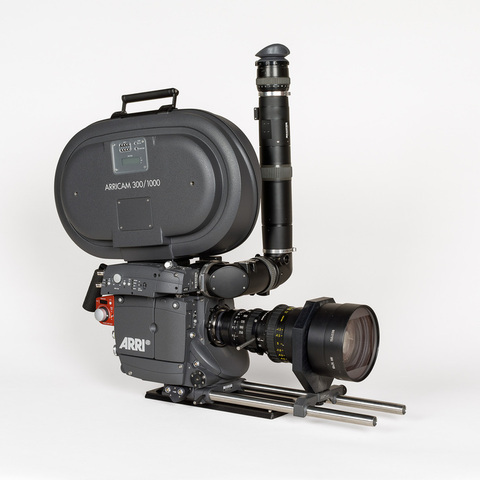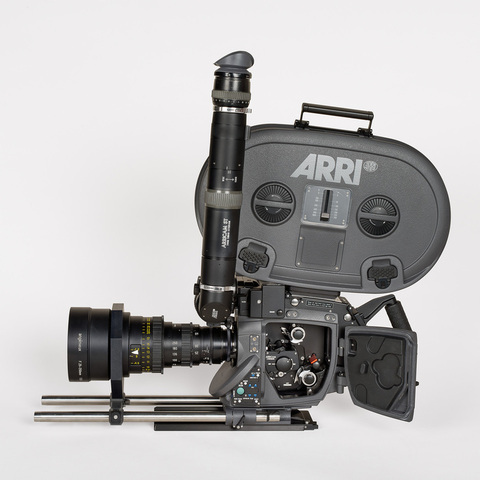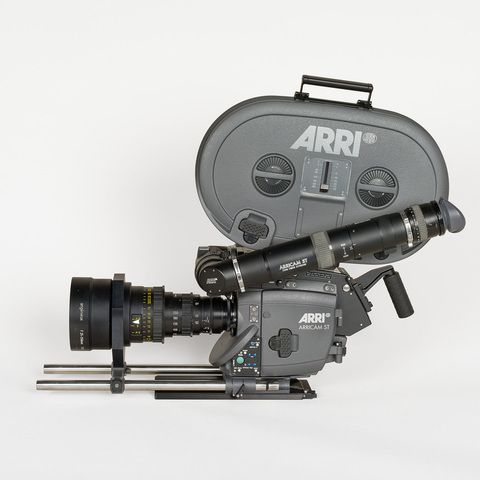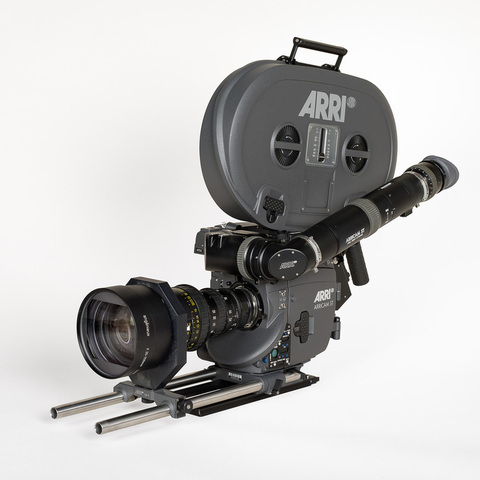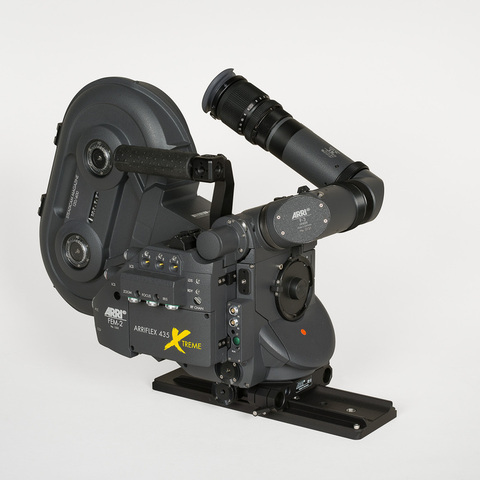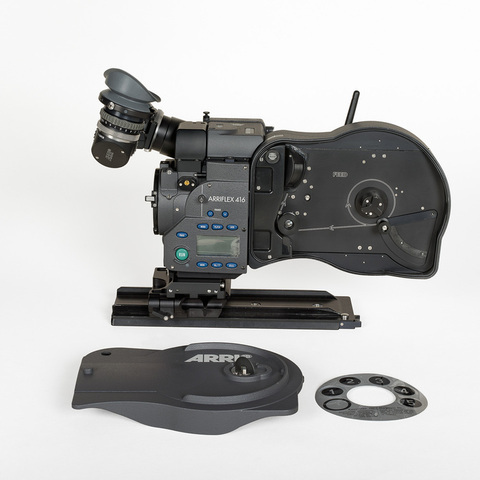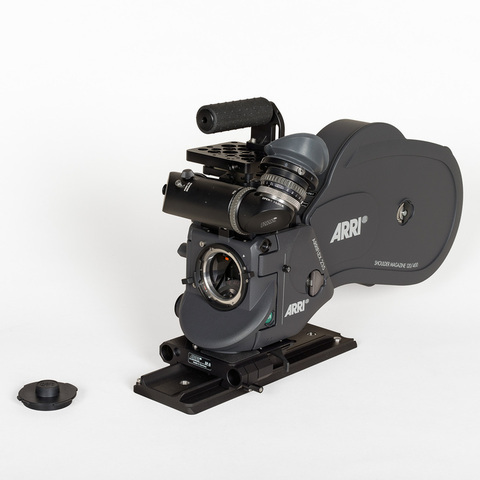Caméra film 35 mm
Fiche détaillée
Type de l'appareil
entraînement du film 35 mm ou super 35 mm par deux griffes et deux contre-griffes réglables pour film à trois ou quatre perforations ; deux débiteurs dentés ; prise de vues quartzée de 1 à 60 images par seconde en marche avant et 1 à 32 i/s en marche arrière, avec speed control box ; moteur électronique ; miroir obturateur électronique réglable de 11°2 à 180° ; visée reflex électronique longue Zoom Finder extension avec ARRI glow ; time-code ARRI ; tableau de commande LCD ; magasin débiteur et récepteur 300 m ; poignée
Auteurs
Informations non disponibles
Fabricants
Arnold et Richter Arriflex
Munich, Türkenstrasse 89
Etablissements Pierre Angénieux
Saint-Héand
Utilisateurs
Informations non disponibles
Distributeurs
Arnold et Richter Arriflex
Munich, Türkenstrasse 89
Sujet du modèle
Informations non disponibles
Objectif
Angénieux Zoom F. 25 - 250 mm, T. 3.5, 10 x 25 HR n° 1 564 596 (don Claude Nuridsany et Marie Pérennou 2017)
Taille de l'objet
Ouvert :
Informations non disponibles
Fermé :
Longueur : 74 cm
Largeur : 29 cm
Hauteur : 67 cm
Diamètre :
Informations non disponibles
Taille de la boîte de transport
Informations non disponibles
Remarques
Marques : "ARRI ARRICAM ST".
Don de la firme ARRI, Munich, 2017. L'objectif Angénieux-Zoom est un don (2017) de Claude Nuridsany et Marie Pérennou, les réalisateurs (entre autres) de Microcosmos.
La caméra ARRICAM (dernière caméra 35 mm développée par ARRI) apparaît en 2000 après le rachat par ARRI de la firme autrichienne Moviecam. Elle est présentée à Londres en 2001 (Image Technology, September 2001, p. 20-22) et Paris au SATIS en 2001 et en février 2002 par Techni Cine Phot et ARRI (Sonovision, n° 460, mars 2002). Elle est déclinée en deux versions : ARRICAM Studio ST (silencieuse, niveau de bruit inférieur à 20 db) et ARRICAM Lite LT (moins lourde mais plus bruyante). Notre exemplaire est la ST pour studio.
"Arri, le grand fabricant mondial de caméras professionnelles (film 16, 35 et 65 mm), annonce aujourd'hui la disponibilité du système Arricam. Un concept révolutionnaire de prise de vue s'articulant autour d'un corps de caméra studio (ST) et d'un corps de caméra portable (LT). Le système entièrement modulaire se distingue par l'interactivité des trois fonctions : diaphragme, obturateur, vitesse. L'opérateur maîtrise en temps réel la qualité de l'image impressionnée et les effets réalisés en visualisant en permanence les données : profondeur de champ, angle obturateur, distance, vitesse de défilement, sur le mini moniteur LCD de contrôle. Nombreux accessoires modulables et dédiés au système : visées, loupes longues, magasins (120-300 m), reprises vidéo, mouvements 3 et 4 perfo interchangeables, moniteurs vidéo LCD, objectifs Ultra Primes avec sensors intégrés" (ARRI Caméras 16, 35, 65 mm, ligne complète de caméras, Paris, Techni Cine Phot, s.d.).
"September 2000. The Cinec was the event this year which most moved film-makers - quite literally : over 6000 visitors came from all over the world to see, among other things, the new ARRICAM system which was shown to the public for the first time. [...] Of the numerous suggestions received at the show, the following have already been integrated into the system : the viewfinder of the ARRICAM stduio was optimised for use with the magazine on top, and can easily be pivoted to the other side of the camera even in this set-up. The Lens Data Display was made smaller and the operating elements were well integrated in the housing. [...] The Speed box was considerably simplified in its user interface. Speed-ramp settings, iris and shutter compensation can be carried out more easily and quickly. The In-Camera Slate Box for the ARRICAM Studio and Lite is now a single unit which can be used for both cameras" (ARRI News, mai 2001, p. 4).
"With the ARRICAM Studio and the ARRICAM Lite, ARRI introduces an innovative and modular 35 mm camera system which combines maximum operating comfort with dependable ARRI precision and reliability. Both cameras offer easy and flexible configuration for any operating situation. The newly designed 5-link movement with dual-pin registration and dual transport claws guarantees optimum image steadiness as well as an ultra-quiet film transport. A three-perforation movement is optionally available for both camera versions. All basic functions as well as en electronically adjustable mirror shutter are available. Expanded function modules with innovative possibilities are fully integrated in the streamlined design of the camera bodies. For the first time, a lens control system has been integrated into the camera body that reads and controls all data of the lens. An ultrasonic measuring tape guarantees faster and more precise operation. The in-camera slate function marks each take legibly and provides economical advantages in post-production and reduced use of film stock" (ARRI ST. LT : The Arricam System, München, Arnold & Richter Cinetechnik, s.d.)
"As always, the ARRI cameras have been built using Rolls-Royce engineering techniques, and the beauty of some of the of the mechanisms really does justify the work of art tag. [...] The ARRICAM Studio and the ARRICAM Lite form an innovative modular 35 mm camera system, each offering easy and flexible configuration for any shooting requirement. The low-noise Studio camera is packed with every feature that you might need, and the Lite is particularly useful when you need to acquire the very best quality 35 mm images in situations where operating freedom is vital, with a small lightweight camera. A key engineering development is the newly-designed 5-link movement with dual pin registration and dual transport claws which provides rock-steady images as well as ultra-quiet film transport. A three-perf movement is also available if required. The cameras offer all the basic functions that you would expect, and an electronically adjustable mirror shutter is available. [...] The precise distance between camera and a hand-held unit can be measured just by pushing a button, far easier than having to pull a measuring tape straight across a complex set, and this is the perfect solution when the camera is mounted high on a crane. The measured distance is stored and indicated on the display and can, if required, be transmitted and set directly on the LDS (Lens Data System) lens. [...] Discussions with various DOPs led to interesting but definitely speculative talk of whether forthcoming improvements in high-definition video cameras would mean that this would be the last ever professional 35 mm camera range from ARRI, and there was much talk of the development work that Panavision are doing on both film and video cameras [...]" (Jim Slater, "An eye on the future", Image Technology, September 2001, p. 20-22).
Bibliographie
ARRI ARRICAM System, user's guide, Munich, ARRI, 2003.
ARRI Caméras 16, 35, 65 mm, ligne complète de caméras, Paris, Techni Cine Phot, s.d. (2002).
ARRI ST. LT : The Arricam System, München, Arnold & Richter Cinetechnik, s.d.
ARRI News, mai 2001, p. 4.
Jim Slater, "An eye on the future", Image Technology, September 2001, p. 20-22.
